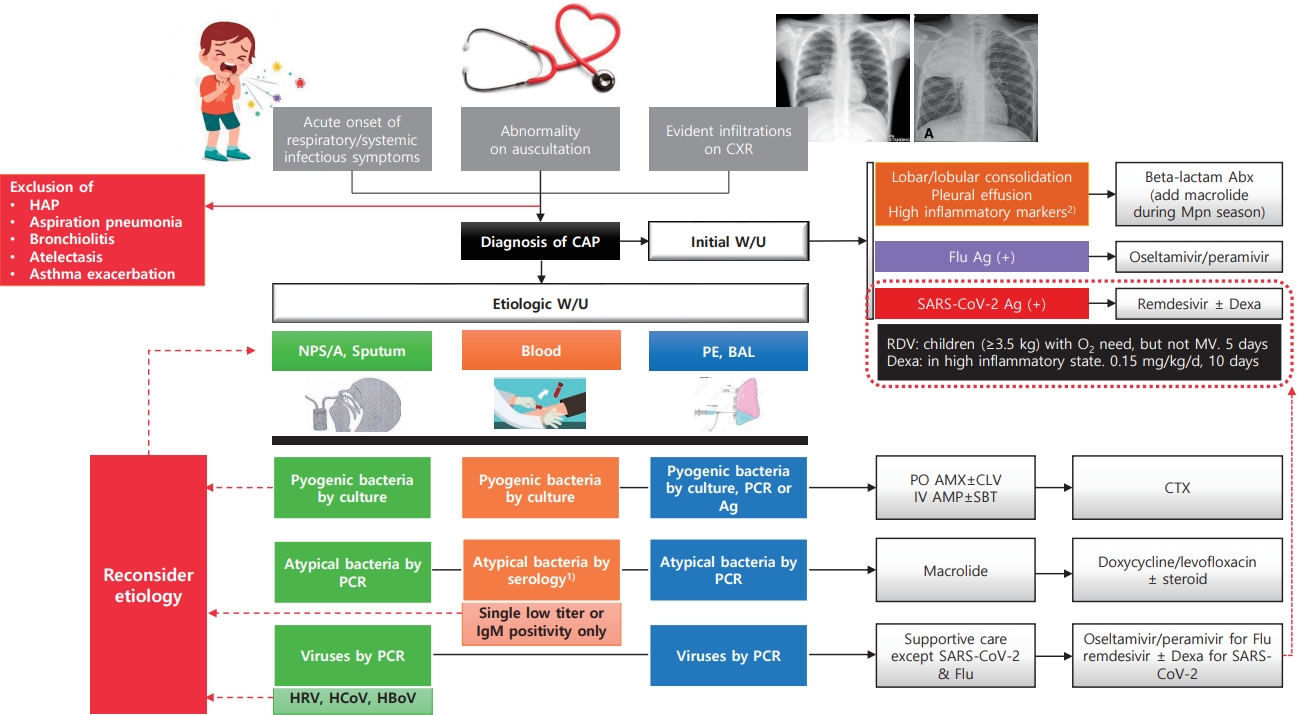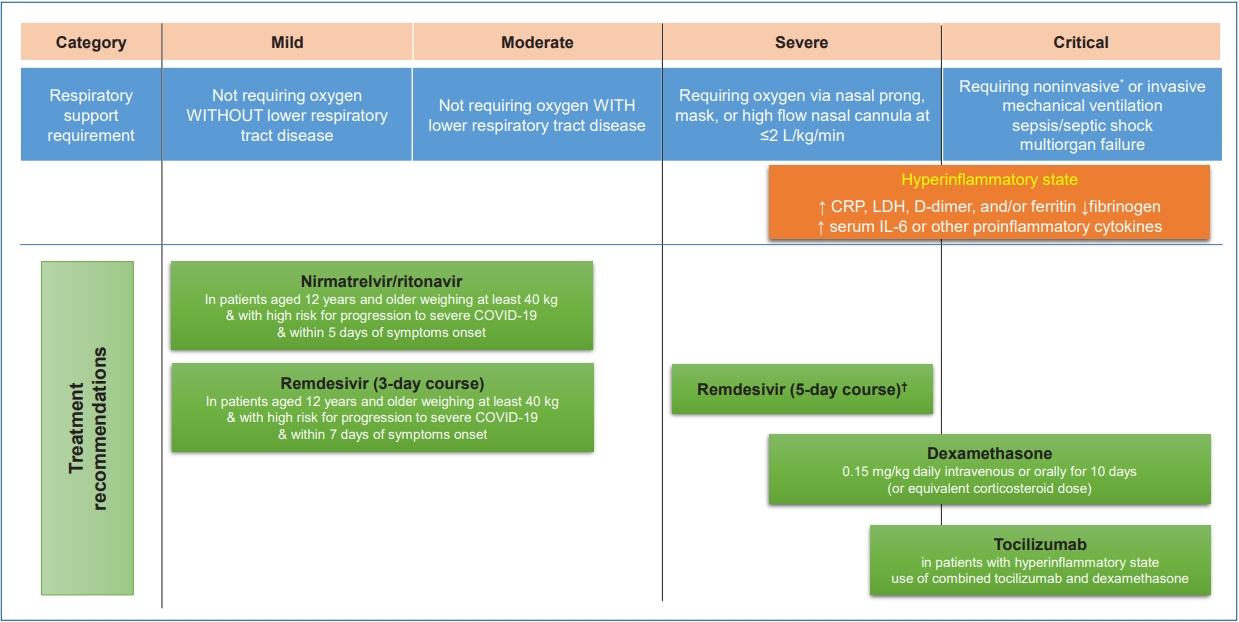- Review Article
- Infection
- Community-acquired pneumonia in children: updated perspectives on its etiology, diagnosis, and treatment
-
Ki Wook Yun
-
Clin Exp Pediatr. 2024;67(2):80-89. Published online June 14, 2023
-

|
· Most commonly confirmed causes of community-acquired pneumonia (CAP) in children are Mycoplasma pneumoniae (8%–40%) and respiratory syncytial virus (15%–20%).
· Pyogenic bacteria, most commonly Streptococcus pneumoniae (40%–50%) and Streptococcus pyogenes (10%–25%), are detected in 2%–5% of children hospitalized with CAP.
· CAP should be diagnosed conservatively according to clinical and radiological criteria.
· The etiology should be identified via appropriate test result interpretation. |
-
-
- Therapeutics for the treatment of coronavirus disease 2019 in children and adolescents
-
Soo-Han Choi, Jae Hong Choi, Ki Wook Yun
-
Clin Exp Pediatr. 2022;65(8):377-386. Published online June 27, 2022
-

|
· Children and adolescents with high risks for severe coronavirus disease 2019 (COVID-19) should be identified and proper treatment should be provided promptly according to the patient’s condition.
· Remdesivir can be considered for pediatric patients of all ages with COVID-19 who have an emergent or increase in supplemental oxygen.
· The use of corticosteroids is not recommended for patients with nonsevere COVID-19. Corticosteroids are recommended in children and adolescents with severe and critical COVID-19. |
-
-
- Perspective
- Infection
- Statement on healthcare system preparedness in response to COVID-19 Omicron subvariants BA.4 and BA.5 surge in Korea from the Korean Pediatric Society and Korean Society of Pediatric Infectious Diseases
-
Eun Young Cho, Dong Hyun Kim, Soo-Han Choi, Ki Wook Yun, Jong Gyun Ahn, Hye-Kyung Cho, Hyunju Lee, Jina Lee, Taek-Jin Lee, Byung-Wook Eun, Jin Lee, Dae Sun Jo, Yun-Kyung Kim, Yae-Jean Kim; Committee on Infectious Diseases of the Korean Pediatric Society
-
Clin Exp Pediatr. 2022;65(11):510-511. Published online September 23, 2022
-
|
|
In order to respond to the recent surge in coronavirus disease 2019 (COVID-19) cases and the continuously changing epidemiology of COVID-19, a sustainable and flexible pediatric healthcare system must be prepared considering the specificity of pediatric care. We demand a more proactive response from the health authorities to check the current state of pediatric COVID-19 patient care and to ensure that pediatric patients receive appropriate and timely management. |
-
-
- Original Article
- Infection
- Uropathogenic Escherichia coli ST131 in urinary tract infections in children
-
Ki Wook Yun, Mi-Kyung Lee, Wonyong Kim, In Seok Lim
-
Clin Exp Pediatr. 2017;60(7):221-226. Published online July 31, 2017
-
|
|
Purpose Escherichia coli sequence type (ST) 131, a multidrug-resistant clone causing extraintestinal infections, has rapidly become prevalent worldwide. However, the epidemiological and clinical features of pediatric infections are poorly understood. We aimed to explore the characteristics of ST131 Escherichia coli isolated from Korean children with urinary tract infections. MethodsWe examined 114 uropathogenic E. coli (UPEC) isolates from children hospitalized at Chung-Ang University... |
-
-
- Usefulness of interferon-γ release assay for the diagnosis of latent tuberculosis infection in young children
-
Ki Wook Yun, Young Kwang Kim, Hae Ryun Kim, Mi Kyung Lee, In Seok Lim
-
Clin Exp Pediatr. 2016;59(6):256-261. Published online June 30, 2016
-
|
|
Purpose Latent tuberculosis infection (LTBI) in young children may progress to severe active tuberculosis (TB) disease and serve as a reservoir for future transmission of TB disease. There are limited data on interferon-γ release assay (IGRA) performance in young children, which our research aims to address by investigating the usefulness of IGRA for the diagnosis of LTBI. MethodsWe performed a tuberculin skin... |
-
-
- Molecular typing of uropathogenic Escherichia coli isolated from Korean children with urinary tract infection
-
Ki Wook Yun, Do Soo Kim, Wonyong Kim, In Seok Lim
-
Clin Exp Pediatr. 2015;58(1):20-27. Published online January 31, 2015
-
|
|
Purpose We investigated the molecular types of uropathogenic Escherichia coli (UPEC) by using conventional phylogrouping, multilocus sequence typing (MLST), and fimH genotyping. MethodsSamples of patients younger than 18 years of age were collected from the Chung-Ang University Hospital over 2 years. Conventional phylogenetic grouping for UPEC strains was performed by polymerase chain reaction (PCR). Bacterial strain sequence types (STs) were classified on... |
-
-
- Clinical significance of matrix metalloproteinase 9 and tissue inhibitor of metalloproteinase 1 and 2 in Kawasaki disease
-
Ki Wook Yun, Sin Weon Sin, Jung Ju Lee, Soo Ahn Chae, In Seok Lim, Eung Sang Choi, Byoung Hoon Yoo, Mi-Kyung Lee
-
Clin Exp Pediatr. 2010;53(4):510-518. Published online April 15, 2010
-
|
|
Purpose : Kawasaki disease (KD) is a systemic vasculitis, a leading cause of pediatric acquired heart disease. Histopathological findings of coronary artery lesion (CAL) in KD indicate destruction of the coronary artery wall with diffuse vasculitis. Matrix metalloproteinases (MMPs) and their endogenous tissue inhibitors (TIMPs) might play central roles in this process. Special attention to MMP-9 has recently been emerging.... |
-
-
- A Study for Accuracy and Usefulness of Tympanic Membrane and Forehead Thermometers
-
Ki Wook Yun, In Seok Lim
-
Clin Exp Pediatr. 2005;48(8):820-825. Published online August 15, 2005
-
|
|
Purpose : The presence and degree of fever in children is a useful indicator of illness. This project aimed to assess the accuracy and usefulness of infrared tympanic membrane(TM) & forehead feverscan thermometers for measuring children's temperatures.
Methods : Data were obtained from 1,050 children with a median age of 4.5 years. They visited the pediatric clinics at Chung-Ang University Yongsan... |
-
-
|














